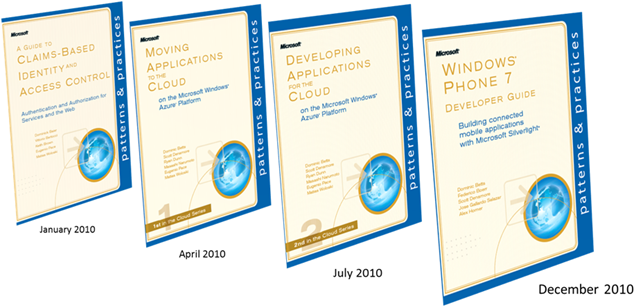A year’s balance–next project
A little bit late for a year balance since the year has already started, or so I’m told. Anyway, as we prepare for the next project, I reflected on my team’s work for the last 18 months. 18 months is more than a year, so you might wonder why am I doing a year balance on the work done on 18 months? Good question.
Does content that nobody sees and uses really exist? Like the tree falling where nobody can listen. Does it make a sound? I figured that what you cared the most is the stuff that was available to you, not what we actually do here in the remote American northwest and keep to ourselves.
Let’s say then, that the output of that last 18 months was available to you in the last 12 months. Makes sense?
And here it is:
A Guide to Claims based Identity
This guide published a year ago, laid the foundations for all subsequent books. We heavily reused the core designs explained in this little book. We also explored a new format for our books, and a new style. This book inaugurated the “tubemap”: the diagram we used from then on to explain in a single picture the entire scope of the content.

Credits to our brilliant partner, Matias Woloski. Little known secret: VS 2010 samples of the book are available on codeplex.
Moving Applications to the Cloud
Our first book specifically focused on Windows Azure. We explored the considerations of migrating (and optimizing) applications for the cloud. As a colorful anecdote, this book includes an Excel spreadsheet with dollar amounts! A technical book with economics! Some were very opposed to it, and $ is a big deal in PaaS (and SaaS, and IaaS, and XaaS)! Money is a big motivator and every month, you get direct feedback on how you are using the platform. Other nuggets worth mentioning: MSBuild tasks to automate deployment, setting up multiple environments (think “Dev”, “Test”, etc.). It’s quite a popular book: made it to the top 25 in O’Reilly this week.
Developing Applications for the Cloud
Our second book on Windows Azure Platform. This time with no legacy constraints. Ah! the joy of building something from scratch using the greatest and latest! Notice the “1” and “2” on the covers of this and the other book? Well, it turns out people had quite some difficulty differentiating one from the other. So we re-designed the cover with the numbers now. Yes, we learned quite a bit on book design too. In addition to the end to end case study,
In addition to the end-to-end scenario (the surveys application we use as the “case study”), a popular chapter has been: troubleshooting Windows Azure apps. My personal favorite content is the little framework we wrote for asynchronous processing with queues and workers. Seems like a common pattern and I’ve already used it in many places.
Windows Phone 7 Developer Guide
The ying-yang of the Microsoft platform in one single book: small, portable devices on one end and the massive, infinitely scalable datacenter in the backend: Windows Phone 7 and Windows Azure. The most controversial aspects of the book? Use of the MVVM pattern is the by far top of the list. Second in the rankings? Use of Rx (Reactive Extensions) for asynchronous communications. Rx is like Linq in its beginnings: mind twisting at first, confusing perhaps, too much “black magic”, but impossible to live without it afterwards. Glad to see the framework available broadly now: .NET, JavaScript, Silverlight, etc.
With regards to MVVM, well…Silverlight might not be fully optimized for this pattern, but we still believe it is worth considering and paying the extra cost if things like testability are important for you. testability is important to us, so we decided to implement it and show you how. We ported Prism to the phone and replaced Unity with Funq for increased efficiency. But of course you don’t have to use any of that. We do expect you to slice and dice the guide as you see fit. Go ahead rip it off.
So, what’s next? What’s next comes in detail in the next post. But here’s in short: what we’d like to do is to extend the identity guide to include some really compelling and demanded scenarios (federation with social identity providers, SharePoint, Access Control Service, etc.) What do you think? Are you passionate about tokens and STSs and claims and WS-Federation, etc.? Have strong opinions on all of these? I’d love to know.
